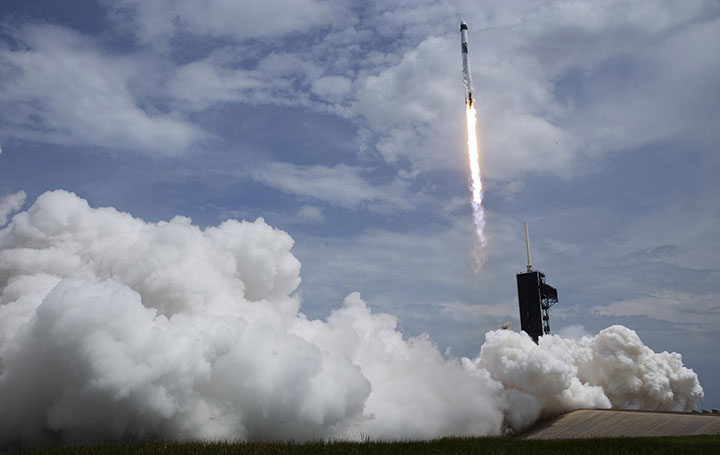
The military has needs and industry has innovation. Where shall the twain meet?
Constellations spoke to Colonel Michelle Idle, the Mobilization Assistant to the Commander, U.S. Space Systems Command, which oversees space acquisition and development, about the new approaches to working with commercial industry to adopt new capabilities, and how industry can better partner with government.
With adversaries upping the tempo to acquire their own capabilities, Idle emphasized, “We have to be as fast as we can,” and that Space Systems Command was acutely aware of the need to rapidly and effectively partner with industry and allies to integrate untapped technology and innovation.
Idle said that required getting out of a transactional mindset and into more of a partnership model, collaborating with commercial entities so as to provide warfighters with what they need going forward.
Which is not easy for the world’s largest employer. Idle said it “takes a lot to turn the big ship,” referring to the Department of Defense and its 3.4 million employees.

Charting a New Path
To help make that change, Idle mentioned the new priorities and philosophies set out by The Honorable Frank Calvelli, the top Service Acquisition Executive who chartered “us to improve how we do business going forward.”
Of the nine space acquisition tenets, Idle said some are focused on government efforts, while others are things the industry can do to help improve the partnership. Those include building smaller satellites and ground systems, minimizing non-reoccurring engineering and “making sure we're delivering ground systems before we actually launch spacecraft.”
On holding industry accountable for results, Idle solicited industry partners to “help make sure we're staying on track with these different projects,” and executing to ensure that the capabilities actually work and are delivered on schedule and on cost.
Idle also spoke about the Space Systems Command Front Door, an initiative to improve outreach into the commercial and small business sector to connect with businesses outside the traditional space and defense industries and help them navigate complex government acquisition.
“With the Front Door we're positioned to better engage with these non-traditional industry partners, and to identify faster some of the capabilities that we might be able to leverage from a military advantage.”
Test Small Before Going Big
But before pivoting or adopting a new technology, Idle explained it would first be tested and proven on a small, localized level before government would ‘jump in and purchase on a larger scale.”
One area that she pointed to as a challenge was data transport. She compared the antiquated systems built “many moons ago,” to AOL dial-up, limited to sending only very structured data very slowly.
When a data line was severed in a storm, she said they used the opportunity to demonstrate how they could do “something different,” connecting one of their sensors back to command and control using Starlink.

With efforts like meshONE-T, they are looking to improve transport across terrestrial and space networks to deliver more information and more types of data to users.
Even so, Idle said that requires maintaining an appropriate balance between faster acquisition and risk so as to not put critical systems or data in harm’s way.
Secure networks that were kept separate from other networks in the past were often naturally stove-piped for good reason; to protect information. But with the need to share data with those who have a “need to know” across the space enterprise, efforts were underway to connect those secure networks to other networks.
“Piping is a very real problem and we're doing our best to get after it, but in a pretty methodical manner.”
Lessons From Ukraine
With Ukraine showing its reliance on non-military commercial assets for imagery and satellite communications, Idle was asked about how the U.S. Space Force envisioned its own commercial integration and plans for future operations.
“I think we're already in the future with some of the things we've seen in Ukraine,” she said of the use of commercial assets and how fast the market is advancing to provide capabilities.
And the Space Force wasn’t alone. She pointed to the National Reconnaissance Office and its purchase of electro-optical and synthetic aperture radar data from commercial sources, and the Space Force and U.S. Space Command, which are ingesting commercial space domain awareness data, as other examples.
Don’t Recreate the Wheel
With commercial space companies and capabilities proliferating, Idle said it was important not to miss opportunities to learn what’s available, so as to not reinvent the wheel and build something new that could be bought off the shelf, and to learn about new mission areas.
Those new areas include space servicing, assembly and manufacturing, and space mobility, for getting cargo into space to help establish infrastructure for the Space Force and future civil missions like NASA’s efforts with cislunar.
Idle said that meant looking across the entire technology readiness level spectrum, including potential technologies that may not be mature yet, but “might play into our systems in the near future.”
“We recognize that Space System Command has got to be available and accessible to the commercial industry, and that industry does need some different paths in order to do business with us.”
To hear more about how industry and government are partnering, and examples of innovation and integration click here.
